We hunters, especially those of you – who like me – enjoy carrying a bolt-action rifle for big game, owe a helluva lot to a German gentleman named Mauser. Peter Paul von Mauser, to be specific. A brilliant designer, Herr Mauser gave us not only the 7×57 and 8×57 cartridges, but the Gewehr 98 rifle, which would set the standard for bolt-action rifle reliability that stands to this day. The Mauser name – synonymous in the firearms world with the reputation that German engineering has secured – is one that hunters have come to rely on for a century and a quarter.
Mauser Continues to Innovate
While there have been over 100 million 98 Mausers produced, the company has not rested upon its laurels; they are forward-thinking, with an ever-evolving sense of the hunting market. I had an opportunity to spend some time with the Mauser Model M12, a fine hunting rifle, and I’m glad to have met it.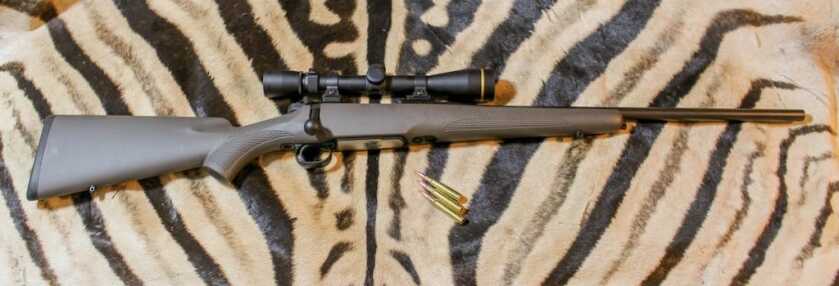
My test model was the Model M12 Extreme, a neat little weather-impervious package that was chambered to the undeniably classic 6.5×55 Swede cartridge – what I consider to be the original 6.5mm gem. The rifle comes in what Mauser calls a ‘soft touch stock’, which is a neutral gray synthetic stock with an exterior that is quiet, non-reflective, and stays in the hands. There are textured areas on the pistol grip and forend, as well as an additional sling stud at the forend for adding a bipod into the mix. A clean, straight comb comes up to the cheek easily, and a slim, textured recoil pad of about ½” keeps that rifle on the shoulder.
[one_half]
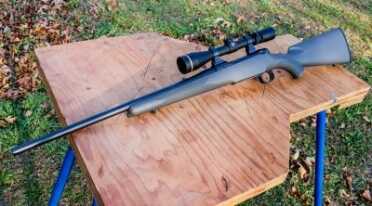
The Mauser M12 Extreme at the bench getting ready for duty.
[/one_half][one_half_last]
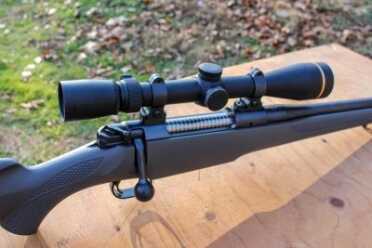
Here’s the right side of the M12 Extreme’s receiver, with oversize bolt knob.
[/one_half_last]
Smooth Ergonomics
The M12 Extreme has a length of pull of 14 3/8”; it felt perfect for me, but I’ve got long arms and usually like a longer LOP. Mauser even offers the option of installing a spacer to increase the LOP to 14 ¾”, and I’ve often wondered why European rifles tend to sport the longer stock lengths. My buddy Michael Ward and I have long debated the reasons for American rifles – usually equipped with a 13 ¾” or shorter LOP – being shorter than their European counterparts, and the best answer we can come up with is that no one knows, it’s just that way. Overall, I feel I shoot the longer LOP rifles a bit better, but again, it comes down to personal preference, just be aware that most European rifles will come standard with a LOP of over 14”.
SPECS: Mauser M12 Extreme
- Type: Bolt-Action repeating, push feed, dual plunger ejector
- Caliber: 6.5x55mm Swedish
- Magazine: Polymer detachable, 5 round capacity
- Stock: Gray synthetic
- Barrel: 22”, blued steel, matte black finish
- Sights: None furnished, drilled and tapped for scope mounts
- Safety: Three-position, wing style
- Weight: 6lbs., 10 oz.
- Overall length: 42 in.
- MSRP: N/A; $~1,400.00 Street Price
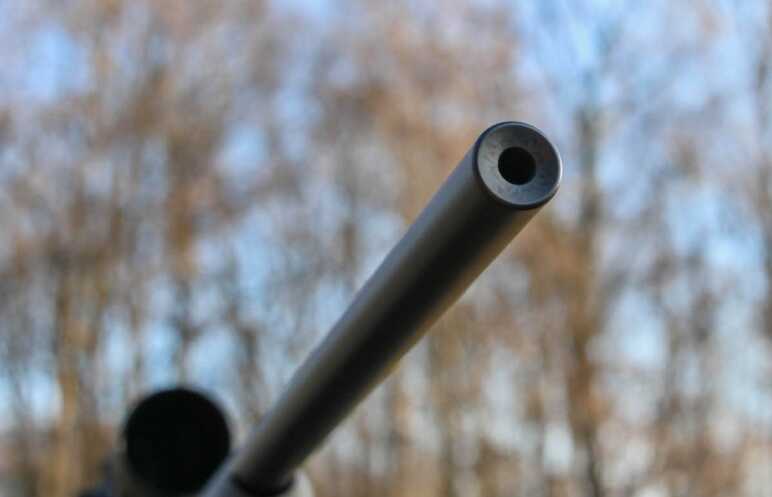
It’s easy to see the concave muzzle of Mauser M12 Extreme.
A detachable polymer magazine, with the Mauser logo on a metal cap along the bottom of the magazine, allows for five shots plus one in the pipe. The magazine is released via a button located on the muzzle end of the floorplate, just behind the forward action screw. Installing and removing the magazine was simple, from any field position.
A 22-inch barrel of medium contour handles the launching duties, and the barrel of my test gun was clean, with no iron sights. A slightly concave crown protects the muzzle just enough to keep things as they should be, without needing a recessed target-style crown. The metalwork on the rifle – with the exception of the bolt itself – is finished in a matte black; perfect for reducing the glare that will spook a game animal so quickly.

The SRS safety and cocking indicator on the M12 bolt is a nice addition.
[one_half][/one_half][one_half_last] [/one_half_last]
[/one_half_last]
The Action, Safety & Trigger
The action of the M12 is a different design than that of the 98 Mauser that we are all familiar with; but that’s not necessarily a bad thing. The design is a push feed affair, but with a 60˚ bolt throw, and six locking lugs located 120˚ apart across the bolt face. That bolt face has an extractor reminiscent of a Remington 700, but uses dual plunger ejectors, and I’ll happily report that the M12 will throw some brass. Throughout the testing of the M12, no cartridge – empty or still loaded – failed to eject. The bolt diameter itself is rather hefty – right around 0.75” – but I’d much rather have things over-designed than the opposite. The jeweled bolt is removed via a button located on the rear left of the receiver; with the bolt rearward you simply depress the button and the bolt with slide out making cleaning a breeze.
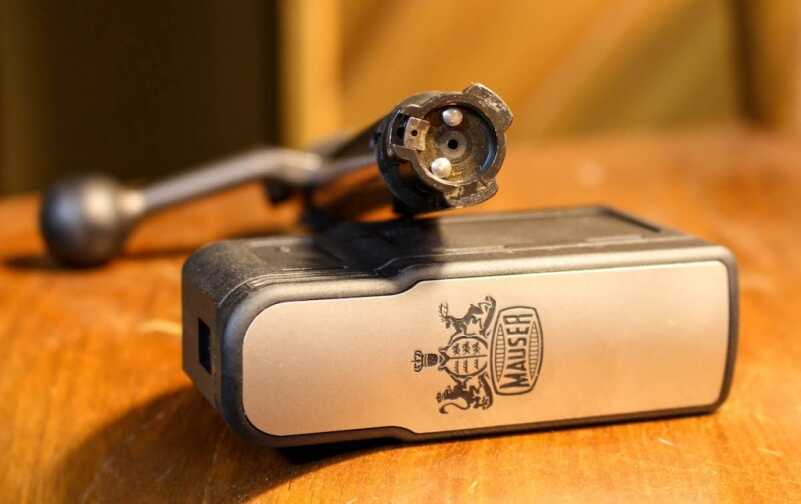
The Mauser M12 bolt face (note dual plunger ejectors) and polymer magazine.
A three position safety, which Mauser calls the SRS, or Smooth-Roll-Safety, which operates horizontally in the manner of the Winchester Model 70, gives the shooter the option of unloading the rifle without putting the rifle into the fire position. The wing lever is larger than most others I’ve encountered, and the quiet, positive feel makes for an easy transition from safe to fire. At the rear of the bolt, the firing pin will extend rearward when cocked, and a bright red indicator lets you know whether or not the bolt is cocked from just about any position. An oversized bolt knob allows for a sure grip when cycling the action, even with gloves in the cold weather. Combine the larger knob with the 60˚ bolt throw, and this makes for a fast cycling rifle.
The M12’s trigger is a real gem. A nice, rounded and smoother feel to the trigger itself is complemented by very little creep or over-travel. The trigger on my test rifle broke at 1 lb. 7 oz., almost like a target trigger. However, the feel of the trigger was not that of other triggers that break this easily; it is certainly light enough for accurate bench work, but from field positions it allowed me to place the shot where and when I wanted. To be honest, it was one of the nicest triggers I’ve felt in a newer rifle.

The Leupold VX-3i 3.5-10×40 scope gave crisp images and a very useful magnification range.
 Scoping the M12
Scoping the M12
For an optics system, I mated the M12 with a Leupold VX-3i 3.5-10x40mm riflescope, giving a perfectly useable magnification range for a hunting rifle, in a nice trim package. Set in Talley rings and bases – which offer a rock solid means of putting and keeping your scope just where you put it – the Leupold’s one-inch tube gave plenty of light transmission for any hunting situation, yet kept the weight down and allowed the scope to be mounted low enough for comfortable shooting.
Riflescopes seem to be growing in both size and weight, and while I appreciate some of the larger scopes for target work, they can tend to become a bit unwieldy in the field, and can actually be a hindrance in the hunting situations where the shots are on the closer side.
The VX-3i
With a low end of 3.5x, the Leupold VX-3i feels right at home in the deer woods, yet that top end of 10x allows a hunter to accurately place his or her shots out to sane hunting ranges. A simple, bold duplex reticle offers a clean view of the target, unlike so many of the complex reticles that seem like they’d feel more at home on a submarine than a hunting rifle.
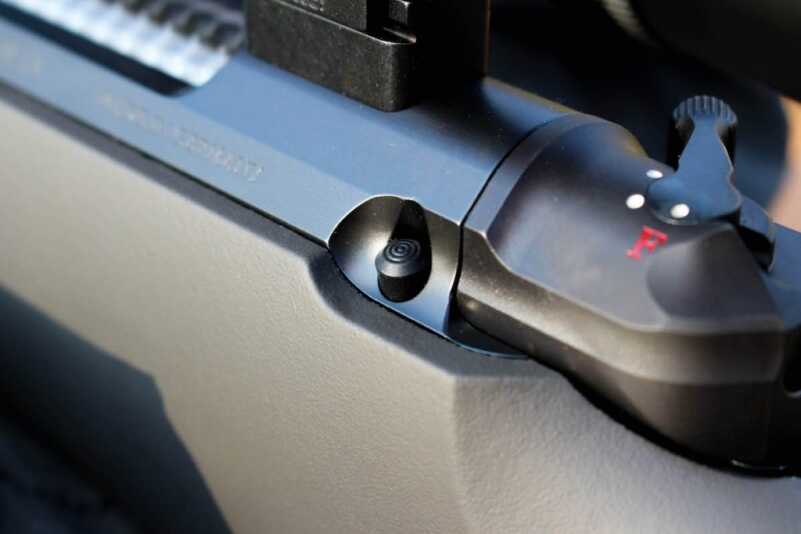
To remove the Mauser M12’s bolt, depress this button on the left side of the receiver and the bolt will slide out easily.
I’ve been a consumer and user of Leupold riflescopes for decades – as they’ve often offered one of the best values on the market – and I’ve noticed a vast improvement in the quality of the lenses on the VX-3i series. From the standard dangerous game scope – the 1.5-5×20 – up through the higher magnification scopes, the VX-3i offers a brighter, crisper image than the VX-3 models did. Yup, I’m a fan.
With ¼ MOA adjustments, a matte finish that complimented the M12 perfectly, and a magnification adjustment ring that could easily be operated with gloves or mittens, the VX-3i 3.5-10×40 seemed perfect for any hunting situation in which you’d use a 6.5mm cartridge. It took adjustment very well, and stayed where I put it; those Talley rings seem to allow a scope to ‘go-to-sleep’. With less moving parts in the equation, there is less to worry about, and the Talleys offer plenty of strength, in both the bases and rings.

Receiver markings of the Mauser M12 Extreme, with Talley rings and bases holding the Leupold VX-3i scope.
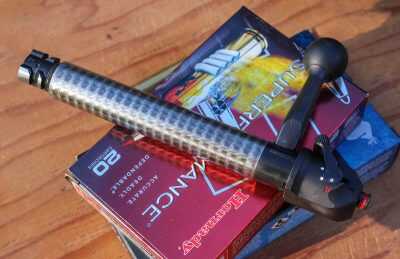
Hefty, jeweled bolt and oversize bolt handle of the Mauser M12 Extreme.
The Cartridge
The Mauser M12 Extreme is available in a number of cartridges, from the .22-250 Remington, through the .270, .308 and .30-’06, up to the .300 Winchester Magnum, .338 Winchester Magnum, and the 9.3x62mm. However, I asked for a test rifle in the classic 6.5x55mm Swedish Mauser cartridge, for a number of reasons. The 6.5×55, in my opinion, is a highly underrated hunting cartridge, one that has offered the benefits of the bore diameter that has been all the rage for the last decade since the late 19th century.
Perks of the 6.5x55mm
It seems that the void that the 6.5 Creedmoor claims to have filled didn’t really exist at all – if you’re coming from the hunting perspective – when you look at the performance of the Swede. It’ll better the Creedmoor’s velocity by almost 100 fps with the 140-grain bullets, and has a case capacity that will take full advantage of the heavier 156 and 160-grain bullets. No slight to the Creedmoor, or any of the modern 6.5mm developments of the last few years, but in a hunting situation I don’t feel there is much of a difference between the performance of the venerable Swede and its contemporary classmates until you get up into the magnum cases. The answer has been in front of our faces since 1894.
The 6.5×55 Swede fits nicely in a long action rifle, and the recoil – especially when compared to the terminal ballistics – allows even a sensitive shooter to place accurate shots on game. One of the undeniable features of the 6.5mm cartridges is that they seem to kill better than they should; Scandinavian hunters have shown the abilities of this bore diameter on game up to and including moose, for over a century. Add the reliability and performance of modern bullets into the equation, and you have a very efficient and pleasant-to-shoot combination in your hands. Yes, there are better choices for the truly large bears, but here in North America, a premium 6.5mm bullet at sane hunting ranges will handle almost all of the average hunter’s needs.
Testing
For testing I grabbed a couple boxes of good hunting ammunition: The Hornady Superformance 140-grain SST load and the Federal PowerShok 140-grain soft point. Both are perfect for deer, antelope and similar size game, and both performed very well. The Federal load gave exactly one-MOA results, with the velocities running at 2,625 fps; just 25 fps below the advertised value.
The Hornady SST showed a bit better accuracy, with groups hanging around 0.8 inch, and a muzzle velocity of 2,740 fps. I’d gladly take either into the field. Additionally, I feel that handloading for the Swede will open up many more doors for a hunter who was interested in using some of the great component bullets available in 6.5mm. Mate the Swede with a heavier Nosler Partition, Swift A-Frame or Barnes TSX and you’ve got great black bear and elk medicine; top it with a 130-grain Swift Scirocco and you’ve got a nice longer-range load, which will hold together regardless of the shot angle.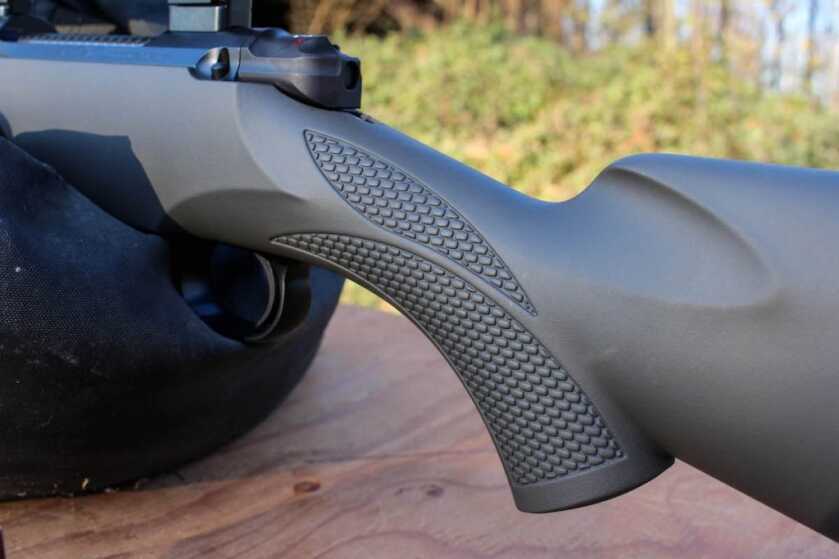
Put it all together and it spells Mauser
What you’ve got in the M12 Extreme is a handy, relatively light (my test rifle weighed 8 lbs, 11 ounces all dressed up for the dance) yet well-balanced package that is impervious to the elements. The Mauser reliability is certainly there; from the safety to the trigger to the magazine to the operation of the bolt, all things felt like a finely tuned machine. The marriage of bolt and receiver ran as smooth as butter, with no chatter or chirps as the action was cycled. With a street price of right around $1,400.00 (sans optics), you end up with an accurate, rugged, and dependable firearm that will serve well for generations.
I can usually find some niggling feature of a rifle that I’d probably change if I could, but the M12 Extreme generated no complaints from me. If anything, any Mauser rifle I’ve ever spent time with has been over-built – whether the modern offerings or the century-old models – and that has played a huge part in the establishing the reputation that Mauser has earned. I can’t imagine a hunter who’d find him or herself questioning their choice when carrying a M12 Extreme, whether they were in the deer woods of the Northeast, the open plains of the West, or the African bushveld. Thank you, Paul von Mauser, for your innovations and for the company that continues to produce fine rifles to this day.
[one_half]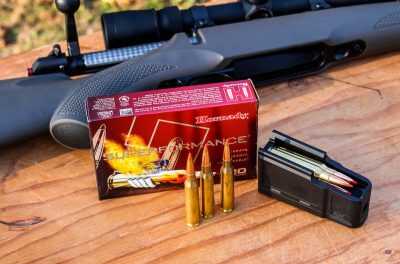 [/one_half][one_half_last]
[/one_half][one_half_last]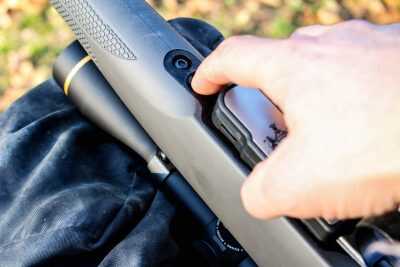 [/one_half_last]
[/one_half_last]
More Info
To learn more information about Mauser rifles, click here.
For more information about Leupold scopes, click here.
To purchase a Mauser rifle on GunsAmerica, click here.

Interesting to read all of the comments about how people wouldn’t buy this rifle because of some supposed fault compared to the original 98. I love the 98. Always have. Always will. I also love my two M12s, one a 7×64 the other a 9,3×62. Synthetic stocks are more practical for the field. Get over it. You could drive over these polymer magazines and not hurt them. Try that with steel. Is it expensive? Compared to what? People don’t seem to whine about the price of a Weatherby Mark V and this is a few hundred cheaper. If you don’t want to pay for a rifle like this then DON’T. But commenting on a rifle you’ve never handled, let alone shot, is the earmark of someone with an agenda—or a troll. In the meantime I’ll just keep on shooting sub-moa groups with my M12s and enjoy their performance in the field.
I have to agree i could build a mause r action much better and cheaper or buy one at gun show
Like others that have posted, I bought 2 M96s about 20 years ago with the specific intent of sporterizing them and making small light recoiling deer rifles for my 2 daughters. I paid all of $75 each, and the rifles are in beautiful condition, especially the metal, perfect bores, and each is over 100 years old. Fast forward to today, they are still hanging on my wall next to two other M96s, and I have been unable to force myself to commit the sin of defiling them from their original condition.
This article, however, has me looking again for a Fagen stock somewhere, and to reconsider wrecking these fine rifles.
I read the story on the new Mauiser M-12 with anticipation until I got to the point where it says “no Iron sights”. How an “Extreme” hunting rifle lacks any sort of backup sights amazes me. You are expected to put your faith in a somewhat fragile telescopic sight and ignore the fact there is no backup available.
I wasted a good (and expensive) hunt because some idiot dropped my cased rifle and the guide’s spare couldn’t be adjusted to work with my admittedly wonky eyes. No rifle, no hunt, tags wasted…all because some idiot in Ame… airlines baggage section decided to drop kick my cased rifle onto the plane.
Ever since, every rifle I own has iron sights and I know how to use them. That means my 1890’s vintage Swedish Mauser remains my go to for 6.5 mm. We’re getting too focused on the trimmings and ignoring the meat, in my opinion; but then at seventy years old, I’ve had a few decades to form those opinions. Mauser, you make a nice rifle, but not for me.
A few years back I bought a Mauser 6.5 for less than $300.It was built in the 30\’s and had seen a war but was in excellent shape and had an excellent NIKON scope on board.. It shoots extremely accurately and handles well. I have since buying it had the stock reduced and checkered with a beautiful wax finish and had the metal cerakoted. Also had the safety repaired as it did not hold. All in all I spent another $400 on the rifle and I have to say it is now not only an excellent hunting rifle but a beautiful piece of work. I guess what I\’m saying is that $1400 for a plastic Mauser is by far too much money
Plastic, plastic, plastic. Everywhere you look. Yes I guess there are certain advantages depending on the situation but – it just doesn’t have the soul of wood and steel.
There is one thing I liked about the plastic mag – that Mauser coat of arms or crest or whatever it’s called. As a proud owner of many Mauser pattern rifles I’d love to have a copy of one of those in a garage size wall hanging. Anybody know where I might find such a thing? Appreciate any info, thanks-
Walnut is grand but if you\’re on stand or riding a horse into some nasty weather, polymer has an awful lot going for it. Steel instead of polymer for some of the components? Well, that\’s a subjective thing. Ask a good engineer familiar with materials and chances he\’ll say it all depends upon the polymer and the steel. Yes, at times, \”plastic\” is superior to steel. It won\’t rust. It can be quieter to insert and extract. It is \”self-lubricating.\” It doesn\’t dent or deform if dropped on a rock in the middle of a hunt. Really, all of these arm-chair firearms experts, if you don\’t like the push-feed, okay. However, pay close attention to these comments: \”..but uses dual plunger ejectors, and I’ll happily report that the M12 will throw some brass. Throughout the testing of the M12, no cartridge – empty or still loaded – failed to eject.\” Get that? The rifle\’s 60-degree lift, its throw, and no errors to eject spent cartridges. For heaven\’s sakes, what more can one want? As for the 6.5×55 caliber, it\’s dandy that\’s been around a very long time and will be around well after all of these fore-mentioned armchair critics are buried with their subscriptions to bunches of gun magazines where they no doubt get much of their firearms knowledge. Such as it is…
$1400 for a plastic stocked rifle, plastic mag and push feed action. Author P. Massaro, get real. I have an original M-96 Swede that I probably paid $300 for. For about $800 you can buy a real Mauser action CZ-550 with a beautiful walnut stock or an excellent Browning A-Bolt Medallion. Who in their right mind would spend over a grand for this M-12. No Thanks!!
Good to see that someone else loves the 6.5×55 SE. It’s one helluva cartridge. But a push feed Mauser? I’ll stick with my CZ with that monster claw extractor.
The junk plasticky magazine made me vote hands down. When will these greed monger Morons who market rifles not realize the average gun buyer would gladly pay more for quality product and will in many cases not buy at all when he sees greed monger cheap shortcuts made to weapons.
The comments are more fun than the article!-:) I have the old M-96 sporterized. It’s fun to shoot. Also have the original stock. One thing about firearms. There’s a lot to learn about them.
I have loved the 6.5×55 since first shooting it in the 1980’s. I could do without the rifle’s price tag, though.
great in all ways except for a plastic magazine,,,,,,why ? a rifle like this requires a steel internal magazine, perhaps with a hinged floorplate,,, great calibers its offered in,,,,,,,might as well buy a crap ruger american with the junk unreliable plastic magazine
A push feed Mauser? Seems like blasphemy
The extractor does not look like a Remington 700 as the article states. It is much more substantial and appears to be more like a push feed winchester extractor.
The BIG problem with long European rifle stocks is scope mounting. Scope mounting must be too far back and this usually means some sort of extended ring for the front ring and that limits avalialbility and also almoust always means a scope mounted too high. I do not understand why the scope on this rifle is mounted so high, it should be 1/2″ lower.
I really wish you had used the designation 6.5X55 S.E. to differentiate this rifle from the Swede. Modern bolt action rifles in this caliber can be loaded to pressures up to 55,000 psi far exceeding the pressure limit of the original loadings. It should be stated very clearly that loads at the pressure should be used ONLY in modern high-strength rifles.
Hard to beat an ‘.06 with a 150 gr cartridge. And, there are arguably many prettier guns with better specs than the 6.5. But, I’ve developed a traditional affection for the 6.5 Swede. First real hunting rifle: sporterized 1896. Been shooting the 6.5×55 since about 1965 when Nomal round-nose 156 gr seemed to be the ONLY cartridges available in our neck of the woods.
. . .Norma…. not ‘Normal’. “Normal” is something else…usually associated with behavior. I know this because it has escaped me many times.
Thank you very much for this highly informative and interesting article. it never failed that the, *in my opinion” the very best if not very close to the very best, I have noted the 6.5 x57. I have owned one of those for so many years it is equipped with what most likely people call a mannlicher stock all the way to the muzzle et **set triggers) a marvelous device.
Sir,
Herr Mauser did not give us 8x57mm. That cartridge cailber was decided on by a German military committee. We call the cartridge 8mm Mauser because the 8×57 chambering was what Mr. Mauser was “forced” to chamber his new bolt action rifle, the K98 in. I did not read the rest of your article after this fail…
Respectfully;
Bradley Bourn
Ah, good catch ol chap! I’m sure you are much the wiser for pointing this out and then ceasing any further learning on the subject. Perhaps there is a future for you in writing for GA? I’m glad you know everything there is to know about “everything Mauser”. I look forward to your writings.
Great. I love it. Lmao